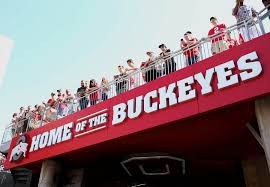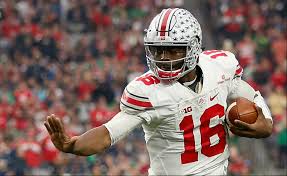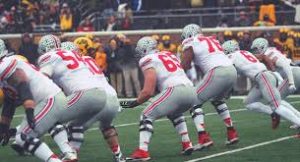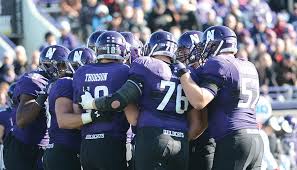Ohio State vs. Northwestern 2016: Game preview, prediction and 6 things to know
Brett Ludwiczak via our friends at Land-Grant Holy Land
Visit their fantastic blog and read the full article (and so much more) here
After two away games, Ohio State returns to Ohio Stadium to host Northwestern on Saturday afternoon.
Saturday night’s loss to Penn State doesn’t erase any shot Ohio State has of making the College Football Playoff, but the Buckeyes have no room for error. Ohio State will look to rebound on Saturday, when they return to Ohio Stadium to host Northwestern after hitting the road for their last two games. The Wildcats make their first appearance in Columbus since 2007, which saw Ohio State have little trouble in the 58-7 victory.
The 24-21 loss in Happy Valley snapped a 20-game winning streak in “true road games” and was the first loss on the road for the Buckeyes under Urban Meyer. The Buckeyes had a great shot to extend the winning streak to 21 games, as they had a 21-7 lead entering the fourth quarter. Grant Haley’s 60-yard return of a blocked field goal for a touchdown with under five minutes left in the game ended up being the game-winner for the Nittany Lions.
The good news for Ohio State is as rare as a loss under Urban Meyer is, even less common is back-to-back losses. In 15 seasons as a head coach, Meyer has only lost back-to-back games four times. The most recent occurrence came during the 2013 season when the Buckeyes dropped the Big Ten Championship Game to Michigan State, followed by losing the Orange Bowl to Clemson. Another reason for optimism going forward for Buckeye fans is that all three of Meyer’s national championship teams had one loss during the regular season.
Ohio State is not only riding a five-game win streak against Northwestern, but the Buckeyes have also won 29 of the last 30 against the Wildcats. The last meeting between the two schools came in 2013, where the Buckeyes rallied from trailing by 10 points early in the third quarter, eventually winning 40-30 in Evanston. Meetings between the schools have become a little more infrequent due to Big Ten expansion and the introduction of the East and West divisions.
After starting the season 1-3, Northwestern is playing their best football of the season, having won their last three games. After embarrassing Michigan State 54-40 in East Lansing two weeks ago, Northwestern returned last week to upend Indiana 24-14. The win on the road against the Spartans gave Northwestern five straight Big Ten wins on the road, dating back to last season.
After two years of failing to qualify for a bowl game with a 5-7 record, last year Pat Fitzgerald and the Wildcats had a bit of a resurgence, posting a 10-2 record before losing in the Outback Bowl to Tennessee. A good portion of the offensive core of the Wildcats returns, which has been a reason why the Wildcats are just a couple wins away from becoming bowl eligible.
Northwestern might have a couple more wins under their belt this year if it hadn’t been for their poor start to the year. The Wildcats fell in their season opener 22-21 to a very talented Western Michigan team. Northwestern followed that loss up with an inexplicable 9-7 loss to Eastern Illinois the next week. Fitzgerald and company quickly righted the ship, and since then have only lost to Nebraska.
Ohio State’s biggest advantages.
A tough nut to crack. Even with the subpar play on offense the last two games, a big reason why Ohio State almost won both of those tough road tests was because of their defense. The Buckeye defense has allowed only eight touchdowns this year, with just two of those coming on the ground. The defense has also held their own in putting up points, score four touchdowns this year, which is tied for second among FBS teams.
The Buckeyes have been especially stingy inside the red zone. Ohio State is second amongst FBS teams in only allowing opponents to score points on 65% of their red zone trips. The Buckeyes are allowing just 14.4 points per game and yielding only 279.7 yards per game to opponents. The 24 points Ohio State allowed to Penn State tied a season-high, as the Buckeyes also allowed 24 points to Oklahoma earlier in the season.
Malik Hooker has been the standout of Ohio State’s defense so far this season, and on Monday was announced as one of 16 semi-finalists for the Jim Thorpe Award, which is awarded annually to the nation’s best defensive back. The sophomore has not only registered four interceptions, which is tied for sixth nationally but is also third amongst Ohio State players with 36 tackles so far this year.
While Hooker and the rest of the defensive backs are patrolling the secondary, the defensive line has been putting plenty of pressure on opposing quarterbacks. The Rushmen package has been a difference maker on obvious passing downs. Tyquan Lewis, Jalyn Holmes, Nick Bosa, and Sam Hubbard make up the defensive line, and even if they don’t end up getting to the quarterback, they ratchet up enough pressure to allow the rest of the defense to make a play.
Sam I am. Ohio State has to find a way to get the football into Curtis Samuel’s hands more, since there is no question the junior is Ohio State’s biggest playmaker. Against Penn State, the Buckeyes went up 19-7 early in the third quarter on Samuel’s 74-yard rushing touchdown. The carry was Samuel’s first of the night, and he only saw one more carry, along with eight receptions for 68 yards.
One the year Samuel is just two yards shy of hitting 1,000 all-purpose yards, and his 142.6 all-purpose yards per game ranks second in the Big Ten. Samuel saw 22 touches in the season opener of Bowling Green, where he accounted for 261 yards. Since then the most touches Samuel has seen in a game came two weeks ago when he got 18 touches against Wisconsin.
With the wide receivers failing to step up for the most part this year, Samuel’s use in the passing game has taken a lot of the pressure of Ohio State’s offense. Samuel leads the Buckeyes with 37 catches, while Noah Brown is second with just 19 catches. If Barrett is able to get the ball to Samuel early in space and give him a chance to make a few moves, it could allow Ohio State to create some distance on Northwestern early.
Quick adjustments. One thing about Urban Meyer teams is when they lose, it usually doesn’t take them long to get up off the mat. Last year it showed after the loss to Michigan State. Just a week later Ohio State went up to Michigan for Meyer’s first meeting with Jim Harbaugh and the Buckeyes had little trouble dispatching the Wolverines. The only other regular season occurrence of Ohio State having to respond to a loss was in 2014, when the Buckeyes had little trouble after losing to Virginia Tech, as they beat Kent State 66-0 the next week.
At Florida there was only two times when the Gators didn’t respond to a loss with a victory. In 2010 the Gators lost to a top-ranked Alabama team, followed by a 12th ranked LSU team the following week. In 2007 Florida lost at home to Auburn and then the following week to top-ranked LSU. Not only does Ohio State have the talent which makes it easier for them to respond quickly, but Meyer has also assembled a talented coaching staff which allows them to identify issues and correct them quickly.
Meyer knows that he can also tell his team that all three of his previous national championship teams had one loss to end the season. If Ohio State doesn’t suffer another setback, takes down Michigan, and wins the Big Ten Championship game it’ll be awfully hard for the committee to leave them out of the playoff. It’ll all have to start with a win on Saturday against Northwestern.
Northwestern’s biggest advantages
A veteran sophomore. Even though he is just a sophomore, quarterback Clayton Thorson already has put together a strong road record, going 6-1 in his seven road starts. Whether it be at home or on the road, Thorson has really improved in his second season taking the snaps for the Wildcats. Thorson has done some of his best work during Northwestern’s three-game winning streak, throwing three touchdowns in each of the wins, becoming the first Wildcat quarterback to accomplish that feat in 20 years. The sophomore is tied for second in the Big Ten with 14 touchdown passes, and ranks third in conference with 1,686 passing yards.
The main receipient of Thorson’s passes this year has been senior Austin Carr, who is leading the Big Ten with 50 receptions, 720 yards receiving, and nine receiving touchdowns. The former walk-on has caught a touchdown pass in six straight games, becoming the first Northwestern receiver to have a streak stretch that long. Carr came into this season with just 23 career receptions in two prior seasons with Northwestern. Last week Carr caught seven passes for 125 yards in the victory over Indiana, marking the fourth time in the last five games in which he has broken the 100-yard receiving barrier.
Action Jackson. Ohio State for the most part has been strong against the run this year, but opponents have been finding some holes over the past two weeks. Corey Clement rushed 25 times for 164 yards against Ohio State two weeks ago in Madison, while last week Penn State’s Saquon Barkley ran for 99 yards on just 12 carries. Quarterback Trace McSorley even found a little success on the ground for the Nittany Lions, rushing for 63 yards.
The Buckeyes will have their hands full trying to slow down Northwestern running back Justin Jackson on Saturday afternoon. The junior has had a great start to his career, rushing for 1,187 yards and 10 touchdowns in his freshman year, and he followed that up with 1,418 yards rushing. Jackson is well on his way to another 1,000 yard season, as he already has rushed for 792 yards. So far this year Jackson has already cracked 100 yards rushing in three games. The best game of Jackson’s season came against Michigan State a couple weeks ago, where Jackson rushed for 188 yards and three touchdowns.
If Jackson is able to find holes in Ohio State’s defense it could open up the passing game for Clayton Thorson and Austin Carr. The mixture of run and pass that Northwestern has working right is a big reason why they have been so successful over the last three games. Even if Jackson isn’t able to find his way rushing the ball, Ohio State has to be wary of Thorson ability to scramble and pick up yards if the play breaks down.
Fitz and the tantrums. Even though the numbers are a little higher than head coach Pat Fitzgerald and defensive coordinator Mike Hankwitz probably want them to be, Northwestern’s defense is playing well right now. The Wildcats are giving up 414 yards per game on the season, but some of those numbers are skewed by giving up 40 points to Michigan State and 31 points to Iowa in victories. In the last three games the Wildcats are giving up just 71.1 yards per game rushing.
Right now Northwestern is getting strong play from players at all three levels of their defense. Defensive lineman Ifeadi Odenigbo is leading the Big Ten this year with eight sacks. Odenigbo’s breakout performance this year came against Iowa, where he registered four sacks in the 38-31 victory over the Hawekeyes. With the issues Ohio State’s offensive line had against Penn State, it’ll be interesting to see if the Buckeyes are able to slow up the senior.
The back-seven of Northwestern’s defense has three players who are having very productive seasons. Coming into the season, Anthony Walker Jr. was being mentioned as one of the best linebackers in the Big Ten, and so far he has lived up to the hype. On the season Walker Jr. has registered 51 tackles, with 5.5 of those tackles being for loss. Joining Walker Jr. in the linebacking corps is Jaylen Prater, who has 58 tackles on the year. Safety Godwin Igwebuike is leading the Wildcats this year with 61 tackles, four of those being for loss.
Summary
F/+ Projection: Ohio State 39, Northwestern 14
Win Probability: Ohio State 92.6%
The numbers say not only should Ohio State bounce back on offense, but they should also return to their normal dominance on defense. Urban Meyer teams typically perform well after a loss, as evidence by his teams only losing back-to-back games four times. Prior to the last two weeks, Ohio State had scored at least 38 points in all five games, and they should be able to crack the 38-point barrier again.
Even though Northwestern does have the talent on offense to make some plays with Thorson, Jackson, and Carr, the Buckeyes certainly have more talent on defense than pretty much every team the Wildcats have played this year. The pass rush that Ohio State is capable of releasing on opposing quarterbacks should be enough to keep Thorson and the Wildcats from creating much momentum on offense.
Continue reading...










/cdn0.vox-cdn.com/uploads/chorus_asset/file/7363085/Fat%20kicker.gif)
/cdn0.vox-cdn.com/uploads/chorus_asset/file/7362159/Samuel.gif)


/cdn0.vox-cdn.com/uploads/chorus_asset/file/7363029/image1.PNG.jpeg)